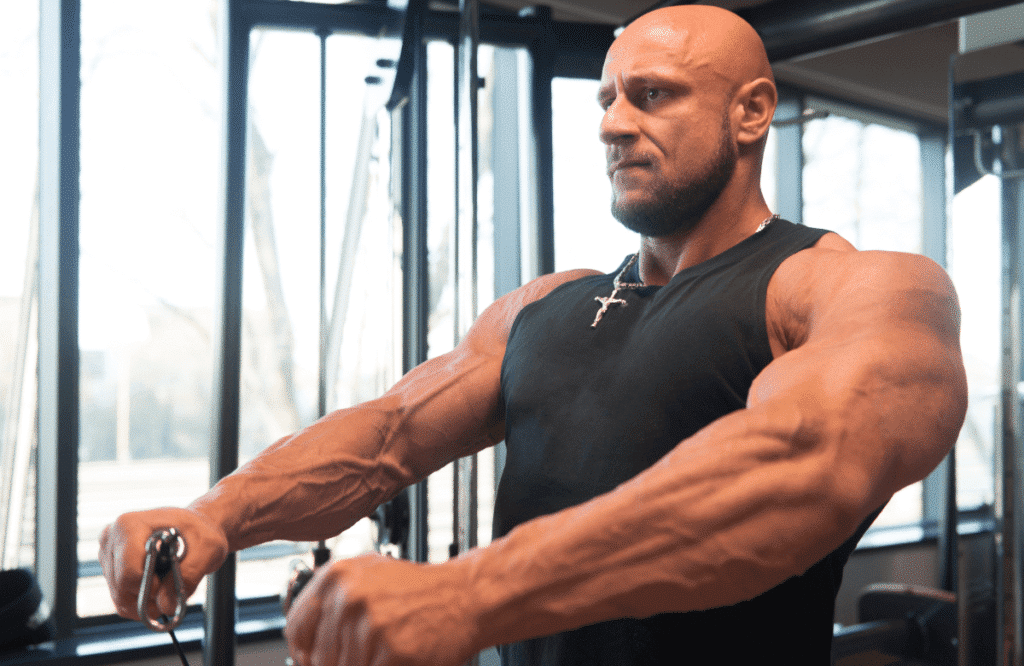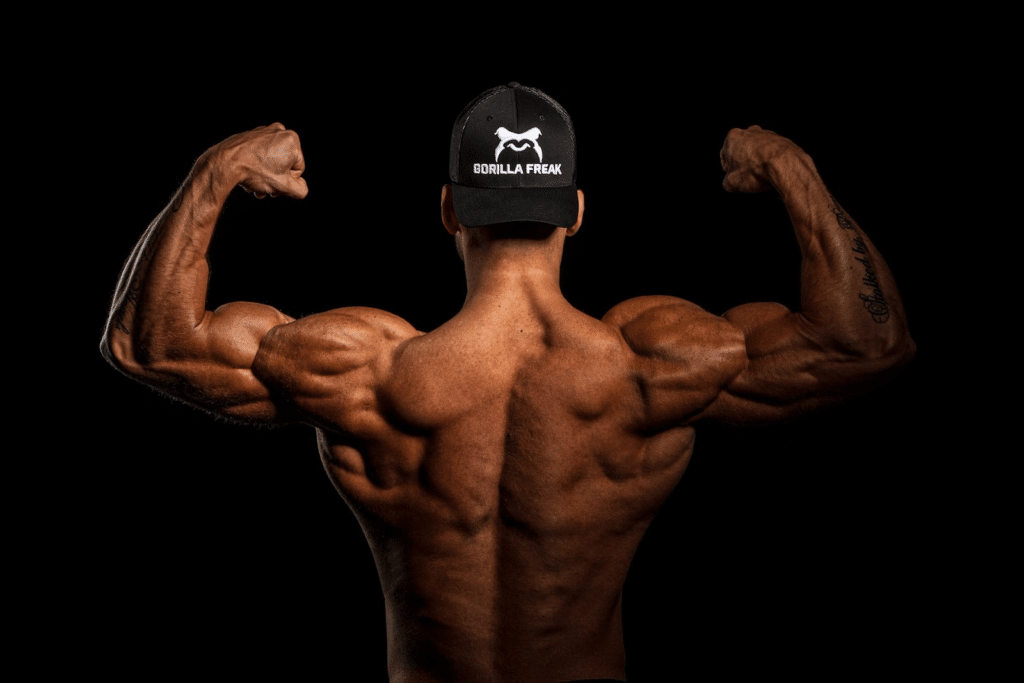The cable machine is an extremely versatile piece of exercise equipment. If you aren’t already using the cables regularly in addition to free weights, you’re missing out! The cables are excellent for upper body workouts, especially for those who want to lift heavy but don’t quite have the stability to do it with free weight yet.
If you’re planning on building a set of dynamite shoulders, then keep reading, because we’re sharing the ultimate guide to cable shoulder workouts. We’ll discuss why cable workouts are such a great tool to have at your disposal, how often you should be doing them, and the 10 best cable shoulder exercises to add to your routine.
Jump to:
- What Are Cable Shoulder Exercises?
- Are Cable Shoulder Workouts Effective?
- What Shoulder Muscles Are Activated?
- Stabilizer Muscles: Rotator Cuff Muscles
- Benefits of Cable Shoulder Exercises
- How Often Should I Train My Shoulders?
- 7 Best Cable Machine Shoulder Exercises
- Who Should Do Cable Shoulder Workouts?
- Tips for Building Muscle With Cable Shoulder Workouts
What Are Cable Shoulder Exercises?
Cable shoulder exercises are movements done using the cable machine that activate the various muscles of the shoulder. They have certain advantages over free weight movements for your shoulder health, so if your gym (or home gym) has a set of cables, they’re worth checking out!
The cables use an adjustable stack of weights and you can use a variety of different apparatus to grab and pull. These include single handles, rope attachments, and a variety of different bars.
Are Cable Shoulder Workouts Effective?
Yes! While free weights can do great things for your shoulder muscles, the cable machine allows you to really hit each muscle from different angles that’s hard to replicate with weights. If you plan it right, you can do a full workout on the cable machine… No fighting for weights in the gym, or wasting time removing and replacing weight plates!

What Shoulder Muscles Are Activated?
The shoulder consists of three separate muscles, the anterior, medial, and posterior deltoids. It’s important to understand where each one is, so you can target each major shoulder muscle separately and grow a serious set of delts.
Anterior Deltoid
Your anterior deltoid is the muscle at the front of your shoulder. You can feel it working on exercises like the bench press, because it’s an important stabilizer muscle for chest workouts. That means it’s easy to overdevelop this particular muscle, though.
You most likely won’t need to work super hard on the anterior deltoid for this reason. It gets a good workout already, so there’s no need to push it hard during your actual shoulder workout.
Medial Deltoid
The medial deltoid is located on the side of your shoulder. It helps with shoulder adduction—in other words, lifting your arm up and out to the side. It’s sometimes also called the lateral deltoid.
Posterior Deltoid
More commonly known as the rear delt, this muscle is located at the back of your shoulder. It’s an important stabilizing muscle for your posture, and it does get worked to some extent when doing upper back exercises.
But the posterior delt muscle is often the most under-developed of the shoulder muscles. It’s essential to work these well during a shoulder workout, because if the anterior and lateral delts are strong and these aren’t, the shoulder joint can become unbalanced. That’s an injury waiting to happen!

Stabilizer Muscles: Rotator Cuff Muscles
The rotator cuff isn’t spoken about as much as the deltoid muscles are when it comes to working out. But neglecting it can make the shoulder unstable, because its function is all about mobility and stability.
It’s made up of 4 different muscles, which we’ll discuss below. Get some rotator cuff exercises into your routine, and you’ll be building a set of bulletproof shoulders.
- Trapezius: A large triangle-shaped muscle that spans across the upper back. Stabilize your head, neck, and shoulders during movement.
- Supraspinatus: The smallest of the rotator cuff muscles, it comes into play when you lift your arms up and to the side.
- Subscapularis: The largest of the rotator cuff muscles, it sits underneath the shoulder blade and is vital for stabilization.
- Infraspinatus: This muscle covers the shoulder blades, helping to stabilize the glenohumeral joint—the ball-and-socket joint that connects the arm to the shoulder.
- Teres Minor: Actually made up of two muscles, it plays an essential part in stabilizing the ball and socket joint.
Benefits of Cable Shoulder Exercises
We’ve already established that building your shoulders is important for upper body stability and strength. But why are cable shoulder exercises beneficial? Here’s a bunch of reasons you should be working shoulders on the cables.
Easy and Safe for Newbies
One of the best things about the cable machine is that it’s ideal for those who are new to lifting. It’s much easier to stay stable and within your range of motion, whereas with free weights, things can quickly go wrong.
With cables, you can lift heavy without less risk of injury. The constant tension in the cable helps you to keep your form more easily, which means you can actually end up lifting more weight than you’d be able to with free weights!
Uninterrupted Time Under Tension
Cable shoulder exercises place the full constant load on your muscles throughout the entire movement. Free weights rely on gravity for resistance, but at some point, there’s a “lull”—a point where it feels lighter, due to your position and the weight’s position in relation to gravity. This is called the strength curve.
With the cables, you don’t have that. The tension remains the same, because it doesn’t rely on gravity at all. That means that at no time during the movement is there that point where the tension is taken off.
So your muscle fibers get more time under tension, which means you’re actually getting more bang for your buck out of cable exercises than you do with free weights.

Constant Load That’s Evenly Distributed
Because the cable machine maintains a consistent tension, unlike free weights, it helps to distribute the weight more evenly as you lift it. This is a handy pro especially for newbies, because there’s much less chance of moving out of your range of motion and injuring yourself.
It allows for a smooth, controlled motion, not only keeping you safe but also allowing you to really feel the muscle activation. Cables are excellent for really getting your mind-muscle connection going, because you really have to control the movement from start to finish.
Switch Up Your Grip
The cables make it easy to choose between overhand, underhand, and neutral grips. Each grip changes up muscle activation a little, so it ultimately makes your workout more robust. It’s also excellent for those who may have weak wrists or injuries that prevent or make it difficult for them to use certain grips.
Cable machines come with a variety of different handle attachments, so you can really find what works for you on any given exercise.
Unmatched Versatility
One of the best things about the cable machine is its unparalleled versatility. Whatever you need or want, you can adjust the cables to accommodate it.
First, the loading angle can be adjusted so you can push or pull from above, below, or directly in front of you. These changes allow for movement in all planes of direction, which means minor differences in muscle activation, so you can really target your shoulders in ways you just can’t with free weights.
Second, the ability to increase or decrease weight quickly and easily makes it simple to do drop sets or supersets. Also, you can get quite creative with the cables, pairing them with a bench, a stability ball, standing, or kneeling.
Between the weight adjustability, the load angle, the variable positioning, and the ability to change up your grip, it’s one of the most versatile pieces of exercise machinery around.
Great For Isolation
The ability to change up your angles and grips really allows you to target every single part of the shoulder joint. You can isolate each muscle quite specifically, which is a great help in building a super set of shoulders.
Because of the constant tension of the cable and the way it’s anchored, the stabilizer muscles need less activation. Using free weights means your stabilizers need to kick in to keep you within your range of motion, especially if you’re going heavy.
Limiting the use of stabilizer muscles means you can really hone in on the muscles you want to build. Note that using cables doesn’t totally remove the use of the stabilizer muscles, it just lessens their activation so the actual shoulder muscles can do most of the work.
Plus, the cables offer a unilateral motion, which means you can work out each side separately with single arm cable shoulder exercises. This is a great way to smooth out muscle imbalances, as you can train one side harder than the other if you need to.

How Often Should I Train My Shoulders?
It’s important to remember that the front delts are activated in many different movements, so they’ll get some exercise when you’re working chest, back, and possibly arms. That means that doing a full, all-deltoids-hit workout a few times a week is going to be overkill for your front delts, but great for your other shoulder muscles.
Twice a week works well for most. You can do a well-rounded shoulder session in one, and then focus on the lateral and rear delts in the second, as your front delts will get more exercise on your other days.
Take note, though, that if your shoulder muscles are still sore from the previous workout… Then you most likely need more rest time in between sessions.
7 Best Cable Machine Shoulder Exercises
Using the cable machine is an excellent way to build your shoulders safely But you still need to choose the best exercises to make sure you’re getting the most effective cable shoulder workout. Here are the ones we recommend.
1. Cable Shoulder Press
The cable overhead shoulder press is one of the best exercises for working the front and lateral delts, as well as the traps. You will get some tricep activation too, but not so much that it takes the focus of the shoulders.
It’s easiest to do when you’ve got a cable machine with two pulleys positioned closely together. Set the pulleys to the lowest position and attach two single handles. Stand with your back to the cables, holding the handles in an overhand grip next to your ears, arms bent at around 90 degrees.
From here, you can push upwards in a regular shoulder press movement . If you’re standing too far from the cable machine, you might find that you feel like you’re being pulled backwards, so adjust your position.
You’ll need to engage your core to help you stand strong. If you feel this is too unstable for you, you can do this same movement kneeling. You can also do an alternating cable press, in which you press one arm at a time.
If you find yourself with a single-cable machine, you can kneel facing the cable and use a short bar. Start with your hands in front of you, at collarbone height, and press the weight from there.
If you feel you need extra stabilization, you can also do a shoulder press variation using an incline bench for stability. Place a bench in between the two cable pulleys and rest your chest and stomach on it as you push.
2. Rear Delt Crossover
One of the best cable machine exercise choices to nail those rear delts! You’ll need a cable station with two cables on either side of you, set at the highest pulley position. No cable handles are necessary for this one—just grab the end of the cable itself.
Grab each cable in the opposite hand. Your starting position should be with the two cables crossed, your arms extended in front of your chest, close together. As you exhale, pull your arms out to the sides and back slightly.
You should feel it in the back of your shoulders. Hold for a second, and then release it back to the starting position, keeping the movement controlled. Make sure not to arch your back during the exercise—brace your core and stand straight throughout the movement.
3. Bent-Over Single Arm Lateral Raise
This one is another fantastic exercise for the lateral and rear delts. This is the cable version of the dumbbell lateral raise, just in a bent-over position. Be warned—it’s tough! There’s constant tension on the cable, so the movement is smooth and your muscles have more time under tension.
You can also move through a larger range of motion with a cable lateral raise than with free weights, and being able to focus on one arm at a time means you can really target those rear delts.
Set a single cable to its lowest setting, with a stirrup handle. You’ll stand with the cable to the side of you, and grip it with the opposite hand—the outer hand. Use an underhand grip.
You want to start with the handle in front of the knee that’s closest to the cable. Hinge at the hips so that your torso is between 45 degrees and parallel to the floor. Place your other hand on your knee for a bit of stability.
Bring your working arm out to the side, keeping a bend in your elbow. You want to go as high as you can without rotating your torso—you should be able to go until your arm is about parallel with the floor, maybe a little more.
Make sure you don’t let the cable pull your arm back down. Control the movement and return slowly back to the start before doing your next rep.
If you want to target the lateral deltoid more and the rear delt less, you can do it standing up straight instead. You can also do it with both arms at once if you have the space on the cable machine.
4. Cable Front Raise
This one’s for the front delts, as its name suggests. Set the cable pulley to its lowest position. You can use either a single stirrup handle for this one if you want to do it one arm at a time, or a bar to do it two-handed.
It’s easiest to do this with your back to the pulley. For single-armed front raises, grab the stirrup with an overhand grip and hold it at your side. As you exhale, lift your hand in front of your body to shoulder height. Hold for a second, and lower it in a controlled manner.
Switch hands to work both shoulders. This is an excellent way to iron out muscle imbalances, as you can train each side to a different capacity.
If you want to do it with both hands, though, you can still do it pretty easily. In this case, run the cable through your legs instead so the center of the force is in the middle. Grab the bar with a shoulder-width grip, keep your core tight, and lift your hands on the exhale.
5. Cable Upright Row
The upright row is an excellent exercise for the front and middle delt muscles, but also really hits those traps! If your shoulder mobility is limited, this one may be difficult, but it’s a worthwhile choice for those with a full range of motion.
Set the cable at its lowest level and use a straight bar attachment that allows you to grip it about shoulder-width apart. Stand facing the cable and hold the bar with an overhand grip, arms fully extended and relaxed.
Exhale and lift the cable up the front of your body, keeping it as close as possible to you. Your elbows should reach shoulder level. Hold it for a second, then release and return slowly to the starting position.
6. Face Pull
Face pulls build the rear deltoids, but also work the upper back muscles and strengthen the rotator cuff when done right. If you work on a computer or have poor posture, this one should be a regular in your workouts to develop stronger shoulders.
Use a single cable and set it to a fairly high position, around chin height. You’ll use a rope attachment for this one. Grab each end of the rope with your thumbs closest to you and palms facing each other.
You may see people doing this exercise with the “wrong” grip. While the above way of holding the rope allows for more external rotation, it’s up to you which is most comfortable for you.
7. Cable Shoulder Rotations
Rotations won’t build muscle, but they will help to improve your shoulder health as they strengthen the rotator cuff. Set the pulley about mid-way down the machine, around waist height with a single handle attached.
There are two versions of this exercise, and it’s valuable to include both: internal shoulder rotations and external shoulder rotations.
For an internal shoulder rotation, your starting position is with the pulley to your side, your elbow tucked against your side, and your forearm at 90 degrees to your body. Without moving your shoulder and keeping your elbow against your body, rotate your arm inwards so your hand touches the front of your body.
For external shoulder rotations, simply turn around so the cable is on your other side. Use the same hand! Keep your elbow tight against your side, and your starting position is with your hand in front of your body, touching your abdomen.
From here, rotate your shoulder and move your forearm outward (externally). Return slowly to the middle position to do it again. There should be no torso rotation and your elbow should stay firmly planted against your side at all times.
You can hold a towel or something similar underneath your upper arm and work on squeezing it throughout the movement. This may be more comfortable for some people.
Who Should Do Cable Shoulder Workouts?
Anyone who wants to build a dynamite set of shoulders! Cable shoulder workouts are good for everyone, but they may be particularly helpful for certain people, such as:
- Those who are new to weightlifting and still learning proper form
- People with shoulder instability who need to build the muscles
- Lifters who want to really target individual shoulder muscles
- Anyone who’s recovering from a shoulder injury
- Those who are pushed for time in the gym

Tips for Building Muscle With Cable Shoulder Workouts
If building muscle is your goal, you can definitely do so with the cables. With the cables, you’re able to lift heavier with better form, which is helpful for muscle hypertrophy. It’s also an excellent way to really build every part of your shoulder, which will give you that “boulder shoulder” look.
It’s also worth remembering that in order to really build muscle, you’ll need to be bulking—in other words, you’ll need to eat in a calorie surplus and make sure you get enough protein to support muscle growth.
In terms of lifting, you should be aiming for 75 to 85% of your one-rep max weight. Men should aim for a rep range of 4 to 6 reps per set, and women should go for 8 to 10. That means using a weight that you can lift with perfect form for 4 reps (8 for women), and stick with it until you can hit 6 (or 10) reps.
That’s your cue to move up in weight, to a weight you can safely lift again for 4 (or 8) reps until you work your way up. This is known as progressive overload, and it’s what’s behind muscle growth and strength gain.
As a final tip, rest for 2 to 3 minutes between sets. This might seem like a lot, but it gives your muscles enough time to recover so that they can continue to lift heavy sets after sets. Do things this way, and you’ll develop a set of strong, powerful shoulders!















